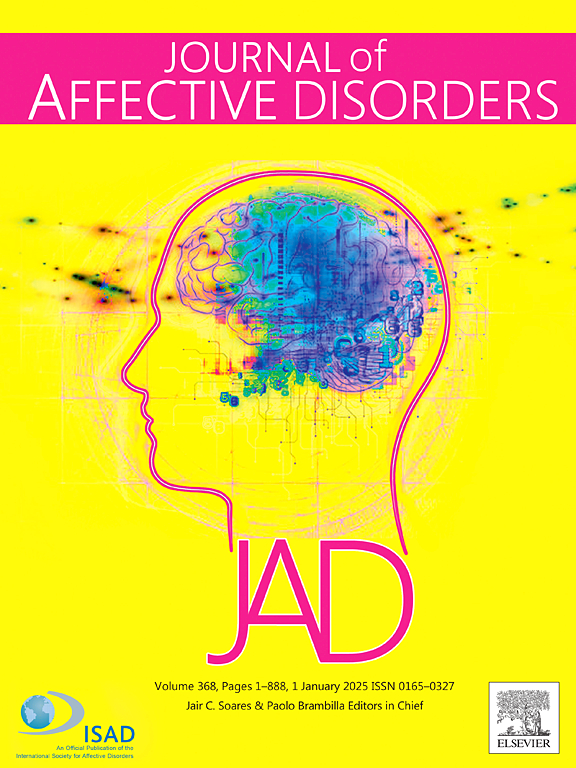使用机器学习解码多波段脑电图特征,预测MDD患者的rTMS治疗反应。
IF 4.9
2区 医学
Q1 CLINICAL NEUROLOGY
引用次数: 0
摘要
背景:重复经颅磁刺激(rTMS)是治疗重度抑郁症(MDD)的一种有希望的治疗方法,特别是对治疗抵抗的病例。然而,确定预测治疗结果的可翻译生物标志物仍未得到充分探索。方法:来自TDBRAIN数据集的治疗抵抗性抑郁症患者在左侧背外侧前额叶皮质(DLPFC)(方案1,n = 44)或右侧DLPFC(方案2,n = 73)进行高频rTMS(10 Hz)或低频rTMS(1 Hz)。收集治疗前脑电图(EEG),测量治疗后贝克抑郁量表(Beck Depression Inventory)的变化。将脑电振荡分解为多频带内禀模态函数(IMF),并将其集成到潜在空间预测建模框架下,识别用于预测治疗结果的特征。结果:多波段特征显著预测rTMS结果(方案1:r = 0.40,p )结论:我们的研究结果表明,机器学习驱动的多波段EEG特征有望用于个性化MDD治疗预测,为改善患者预后提供了可翻译的途径。本文章由计算机程序翻译,如有差异,请以英文原文为准。
Multiband EEG signatures decoded using machine learning for predicting rTMS treatment response in MDD
Background
Repetitive transcranial magnetic stimulation (rTMS) is a promising treatment for major depression disorder (MDD), particularly for treatment-resistant cases. However, identifying translatable biomarkers predictive of treatment outcomes remains underexplored.
Methods
Participants with treatment resistant depression from the TDBRAIN dataset underwent either high frequency rTMS (10 Hz) at the left dorsolateral prefrontal cortex (DLPFC) (Protocol 1, n = 44) or low frequency rTMS (1 Hz) at the right DLPFC (Protocol 2, n = 73). Pre-treatment electroencephalograms (EEG) was collected, and changes in Beck Depression Inventory were measured post-treatment. EEG oscillations were decomposed into multiband intrinsic mode functions (IMF) and integrated under a latent space predictive modeling framework to identify signatures for predicting treatment outcomes.
Results
Multiband signatures significantly predicted rTMS outcomes (Protocol 1: r = 0.40, p < 0.01; Protocol 2: r = 0.26, p < 0.05). Key spatial patterns linked to treatment outcomes were identified, revealing three main oscillations: IMF-Alpha, IMF-Beta, and the residual signal. In Protocol 1, critical regions included the left frontal and parietal regions for IMF-Alpha, left frontal-central and right parietal regions for IMF-Beta, and bi-hemispheric central and left parietal-occipital regions for residual signals. In Protocol 2, critical regions involved the left frontal and parietal regions for IMF-Alpha, left frontal-central region IMF-Beta, and right frontal, left frontal-central, midline central, and left parietal-occipital regions for residual signals. These oscillatory features also showed correlations with specific personality measures, suggesting their potential clinical relevance.
Conclusion
Our findings demonstrate the promise of machine learning-driven multiband EEG signatures for personalized MDD treatment prediction, offering a translatable pathway for improved patient outcomes.
求助全文
通过发布文献求助,成功后即可免费获取论文全文。
去求助
来源期刊

Journal of affective disorders
医学-精神病学
CiteScore
10.90
自引率
6.10%
发文量
1319
审稿时长
9.3 weeks
期刊介绍:
The Journal of Affective Disorders publishes papers concerned with affective disorders in the widest sense: depression, mania, mood spectrum, emotions and personality, anxiety and stress. It is interdisciplinary and aims to bring together different approaches for a diverse readership. Top quality papers will be accepted dealing with any aspect of affective disorders, including neuroimaging, cognitive neurosciences, genetics, molecular biology, experimental and clinical neurosciences, pharmacology, neuroimmunoendocrinology, intervention and treatment trials.
 求助内容:
求助内容: 应助结果提醒方式:
应助结果提醒方式:


